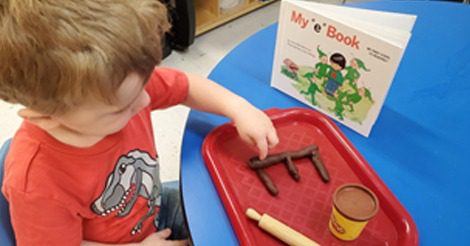 In literacy this month, we are sounding out letters while utilizing our senses. By using the five senses, children will retain the knowledge of simple phonics and writing skills they’ve learned critical to school age learning, while having fun in the process. Using materials from the Handwriting Without Tears program utilized in our curriculum, the experience of learning how to sound out and write letters becomes an interactive process. The skill of knowing what sound each letter makes, as well as understanding the formation of letters, is key to early school success.
In literacy this month, we are sounding out letters while utilizing our senses. By using the five senses, children will retain the knowledge of simple phonics and writing skills they’ve learned critical to school age learning, while having fun in the process. Using materials from the Handwriting Without Tears program utilized in our curriculum, the experience of learning how to sound out and write letters becomes an interactive process. The skill of knowing what sound each letter makes, as well as understanding the formation of letters, is key to early school success.
Age-appropriate Adaptations:
- Two-year-olds—Fun songs which incorporate letters, such as the ABC’s song, is a great auditory way for your child to learn their letters. Other songs such as “B is for Billy” will not only help your auditory learner memorize letters of the alphabet, but he will also be learning the first letter of his name as well! Helping your toddler form uppercase letters using playdoh is a perfect sensory activity to help your child retain what each letter looks like, and what shapes form the letters. This is also a great fine motor activity to build those small muscles in the hands! As an extra tip, add a spice, such as cinnamon, to the playdoh to enhance the sensory experience! Comparing shapes traced in sand to pictures of uppercase alphabet letters will help your child understand that letters are essentially shapes! Another great activity that will encourage sight and touch is building letters using wood blocks.
- Three-year-olds—Creating uppercase letters using painter’s tape on a table is a wonderful fine motor activity, as well as a literacy activity that will help your child understand the formation of letters. Repetition of letter sounds such as, “A is for ah, ah, apple” will help your child retain the knowledge needed for later reading comprehension. One of our favorite alphabet books is Chica, Chica Chica Boom Boom by Bill Martin Jr. This book offers a repetitious melody to help your child memorize the letters of the alphabet, as well as vivid images. Your three’s will also love to bake the alphabet by rolling cookie dough into alphabet shapes.
- Four-/Five-year-olds—Ready, set, it’s off to Kindergarten you go! But first, let’s learn letters. Listing words that begin with the letter of the week will make your child feel included in the learning process of the class. Magnet boards, wood blocks, small sand boxes, and molding dough are all great tools in the formation of letters, as well as developing fine motor muscles in the hands. They will be having so much fun, they won’t even know they’re learning! Forming letters using their bodies and attempting to form letters using music ribbons are a great way to learn the alphabet and get those wiggles out with a gross motor activity. A letter hide-and-seek game or a letter scavenger hunt will turn learning the alphabet into a fun competition!
Skills Supported: fine motor skills, sensory experience, literacy and phonics knowledge, gross motor skills, handwriting skills.
